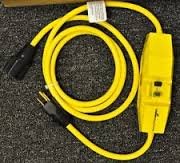Sunset
Senior Member
- Joined
- May 12, 2013
- Messages
- 278
- Location
- Canada
- Vessel Name
- Manatee
- Vessel Make
- 1976 Albin 25 DeLuxe
I would like to install a new 15A plug-in (for my new 12A Promarine battery charger) in place of the existing ancient and disconnected AC shore power receptacle. Is there some way to remove this old thru-hull fixture, or would I be better off simply drilling a new thru-hull?

